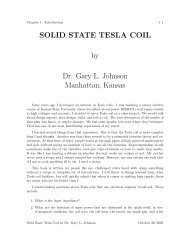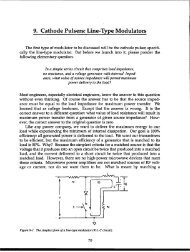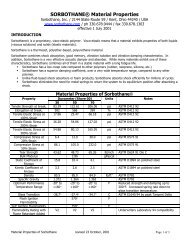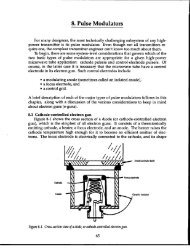3.6M north10.pdf - Dean-O's Toy Box
3.6M north10.pdf - Dean-O's Toy Box
3.6M north10.pdf - Dean-O's Toy Box
You also want an ePaper? Increase the reach of your titles
YUMPU automatically turns print PDFs into web optimized ePapers that Google loves.
Cathode Pulsers: Hard-Tube Modulators (10) 199<br />
klystron beam current of 130 A peak is shared equally among the three L-5097<br />
switch tubes, 41.7 A each. They sha~ current without external isolation components<br />
in quite the same fashion as MOSFETS.<br />
The modulating anodes of the three switch tubes are driven from a common<br />
pulse source that is configured as a “floating-deck” modulator (which is the next<br />
general category of modulator to be considered). This design satisfies a previously<br />
mentioned requirement it behaves as both a source and a sink for the<br />
BST’S modulating anode displacement currents, which are magnified by the<br />
“Miller” effect. Both driver stages use four parallel-connected, high-performance,<br />
pulse-rated tetrodes (type Y-543), operating with 1250-V screen supplies. The<br />
“pull-up” stage is a “bootstrap” circuit, which means that the common connection<br />
for screen and filament supplies and for the low-level drive circuit is the<br />
pulse-output bus, which is, so to speak, pulled up by its bootstraps. The driver<br />
output is capable of pulsing the modulating anodes of the BSTS to 14-kV positive<br />
and returning them to an interpulse negative bias level of -600 V (which is not an<br />
absolute necessity for zero BST current).<br />
As shown in Table 10-1 by the listed ensemble of pulse waveforms, including<br />
doublets and multi-pulse bursts, advantage is clearly being taken of the electronic<br />
agility of the full-control hard-tube modulator switch. Pulse-top variations<br />
are 0.l% and pulse-to-pulse variations are 0.02Y0. Both of these performance<br />
achievements are facilitated through the attenuation of power-supply variations<br />
by the relatively high incremental-source resistance of the BSTS. The source<br />
resistance of each one is 75,000 ohms, giving a parallel-combination resistance of<br />
25,000 ohms for the three tubes. The operating-point incremental resistance of<br />
the klystron, AEIJMh is 640 ohms. Therefore, the voltage-attenuation factor is<br />
25,000 ohms divided by 640 ohms, or 40, which is 32 dB.<br />
This is but one of a number of highly successful, highly precise pulse modulators<br />
that share very similar circuitry but use different numbers of parallel BSTS.







